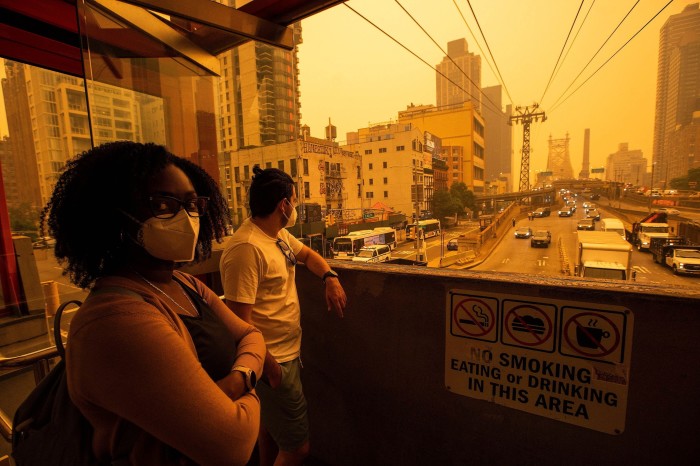We need new tools to predict climate risks

Roula Khalaf, Editor of the FT, selects her favourite stories in this weekly newsletter.
Riccardo Rebonato is professor of finance at Edhec Business School and scientific director of the EDHEC-Risk Climate Institute
As global temperatures rise, financial and policy planners badly need a way to forecast the implications. Yet the unprecedented nature of climate change means we must devise new approaches to complement the traditional statistical tools used to better tame risk.
International bodies, including the Intergovernmental Panel on Climate Change (IPCC) and the Network for Greening the Financial System (NGFS), have sought to fill the gap by setting out several different climate warming scenarios. These have provided much-needed guidance to policymakers and financial planners, from investment managers to corporate executives. But they all share conceptual features that limit their usefulness.
Think of the existing approach to scenario mapping as a table, which sets out five socio-economic narratives (so-called Shared Socioeconomic Pathways, or SSPs) on one side and possible warming scenarios (Representative Concentration Pathways, or RCPs) on the other.
Each option — for instance “Middle of the Road”, where there is slow progress towards changes in environmental behaviour — sets out the projected impact on factors such as economic growth, population and technological development. Each narrative must be coupled with each possible end-of-century warming level.

This coupling is achieved using a model that combines economics and physics modules. The parameters are adjusted to reflect the socio-economic narrative, and the models calculate the implied “carbon tax” required to achieve the temperature target.
Recent scrutiny, however, has highlighted several flaws in this approach. For each “story”, the links between the macro-financial variables are totally rigid: one assumption on economic growth results in a certain assumed level of population growth, or to a particular level of technological development, and so on. This greatly limits the possible outcomes and can engender an unwarranted sense of control. Climate black swans are shot down before they can even take flight.

Yet there is a deeper problem: no attempt is made to assign a probability to the various story/warming combinations. There are good reasons to remain probability-agnostic. However, a scenario without any probability attached to it is of little use. Precisely because resources are limited and the scale of a serious abatement push is little short of a war effort, financial and policy planners need an idea of which scenarios they should most worry about.
Absent any guidance to the contrary, assigning equal probabilities to the narratives and the projected warmings is intuitive. But it is also unwarranted and potentially dangerous. For example, one scenario, the RCP8.5, has been criticised in science journal Nature for being virtually impossible, yet it is one of the most frequently quoted scenarios in applied work.
Is there a way out of this impasse? Does the uncharted nature of the problem condemn us to live without probabilities? Not necessarily. Assigning probabilities to the socio-economic narratives is very difficult. But if we are interested in their climate consequences, these narratives ultimately translate into paths for economic growth, emissions and technological development.
We know less about these factors than we would like. But we do have some information about economic growth; on how technological barriers limit the speed with which we can cut emissions; about the fastest rates of decarbonisation observed to date; or the link between investment in abatement technology and technological progress (what economists call “learning by doing”).
From this knowledge, imperfect though it is, we can build analytical tools that both keep track of uncertainties and make good use of the information that we do have.
Some exciting possibilities are being explored. Dynamic Bayesian Nets, for instance, try to add a probabilistic dimension to the SSP/RCP framework by combining our degree of ignorance with what we do know. These probabilities will never be precise, but being able to say “Scenario A is 10 times more likely than Scenario B” or “Scenario C is much less likely than all the others” would already be a very useful step in the right direction.
FT Masters in Finance ranking 2023

Find out which schools are in our ranking of the top 55 pre-experience postgraduate finance degrees. Also, learn how the table was compiled and read the rest of our coverage.
This will make a difference. Financial planners desperately want to assess “what climate change may mean” for them. They have made extensive use of the NGFS scenarios, yet few realise that all of these scenarios are offshoots of the “Middle of the Road” (SSP2) narrative. Not surprisingly, rare events are totally missing, and there is no way to gauge their likelihood. As a result, planning is difficult and the risk of complacency is high.
Equity prices barely seem to reflect either the major reallocation of investments required to seriously tackle climate change and the resulting losers and winners in different industrial sectors; or the aggregate impairment to economic output that failure to take climate action will entail.
A better understanding of the likelihood of the full range of possible outcomes, and of what we should really worry about, could change this picture for the better.
Climate Capital

Where climate change meets business, markets and politics. Explore the FT’s coverage here.
Are you curious about the FT’s environmental sustainability commitments? Find out more about our science-based targets here

Comments